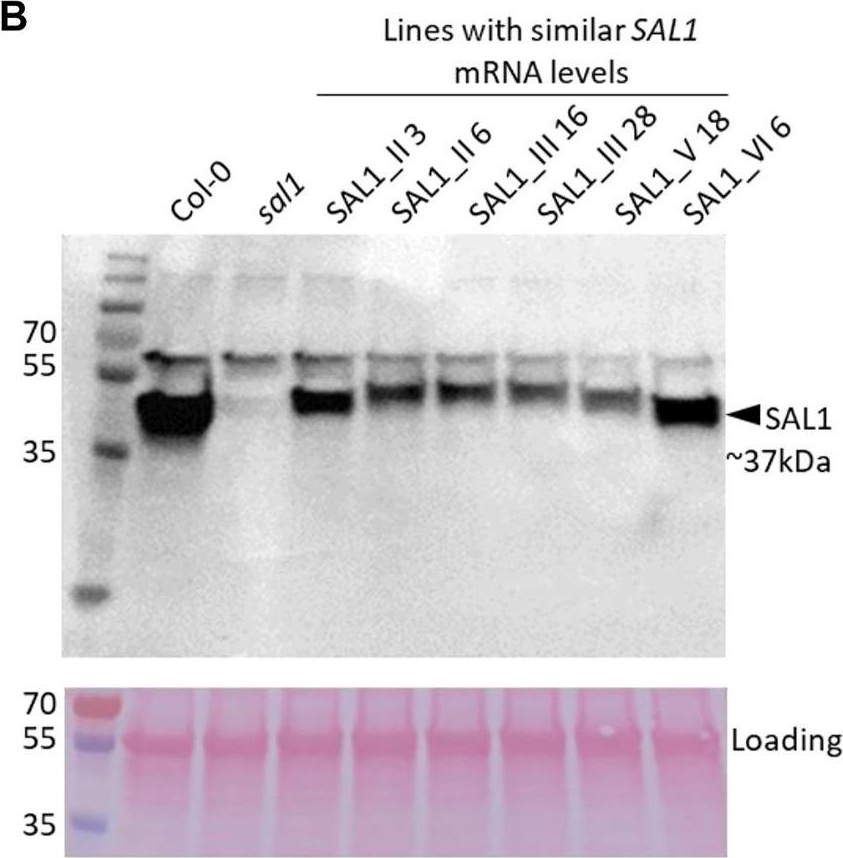1

Anti-SAL1 | Sal1 phosphatase
AS07 256 | Clonality: Polyclonal | Host: Rabbit | A.thaliana, P. tremula, L. esculentum, G. max, N. tabaccum
- Product Info
-
Immunogen: Recombinant SAL1, full-length protein, 353 amino acids. The cDNA of SAL1 (At5g63980, protein Q42546) was cloned into pHUE expression vector and the protein has been produced and purified according to Baker et al 2005
Host: Rabbit Clonality: Polyclonal Purity: Serum Format: Lyophilized Quantity: 100 µl Reconstitution: For reconstitution add 100 µl of sterile water Storage: Store lyophilized/reconstituted at -20°C; once reconstituted make aliquots to avoid repeated freeze-thaw cycles. Please remember to spin the tubes briefly prior to opening them to avoid any losses that might occur from material adhering to the cap or sides of the tube. Tested applications: Western blot (WB) Recommended dilution: 1 : 1000 (WB) Expected | apparent MW: 37.5 | 41 kDa (Arabidopsis thaliana)
- Reactivity
-
Confirmed reactivity: Arabidopsis thaliana, Glycine max, Lycopersicum esculentum, Nicotiana tabaccum, Populus tremula Predicted reactivity: Gossypium hirsutum, Oryza sativa
Species of your interest not listed? Contact usNot reactive in: Chlamydomonas reinhardii
- Application Examples
-
application example

7.5 µg of total leaf protein extracted with PEB (AS08 300) from (1) Nicotiana tabacum, (2) Glycine max, (3) Lycopersicon esculentum, (4) Chlamydomonas reinhardtii, (5) Populus tremula and (6) Arabidopsis thaliana were separated on 4-12% NuPage (Invitrogen) LDS-PAGE and blotted 1h to nitrocellulose. Filters were blocked 1h with 2% low-fat milk powder in TBS-T (0.1% TWEEN 20) and probed with anti-SAL1 (AS07 256, 1:1000, 1h) and secondary anti-rabbit (1:20000, 1 h) HRP-conjugated antibody in TBS-T containing 2% low fat milk powder. Antibody incubations were followed by washings in TBS-T (15, +5, +5, +5 min). All steps were performed at RT with agitation. Signal was detected with chemiluminescent detection reagent, using a Fuji LAS-3000 CCD (240s, standard sensitivity).
Application examples: 
Reactant: Homo sapiens (Human)
Application: Western Blotting
Pudmed ID: 35127814
Journal: Front Mol Biosci
Figure Number: 9B
Published Date: 2022-02-08
First Author: Flügge, U. I.
Impact Factor:
Open PublicationSAL1 protein levels in best-complemented sal1 lines expressing SAL1 in different subcellular compartments and in complemented sal1 lines expressing similar SAL1 mRNA levels. SAL1 protein levels were analyzed in total protein extracts of 25-day-old rosette leaves from the best-complemented line of sal1 expressing the different constructs I–VI (A) and diverse complemented sal1 lines with similar SAL1 mRNA levels (∼10-fold overexpression compared to Col-0) (B). Immunoblotting was performed with an anti-SAL1 antibody and a horseradish peroxidase (HRP)-conjugated secondary antibody against 20 µg total protein per sample. The SAL1 protein was detected at approximately 37 kDa, with no SAL1 protein in the sal1 mutant sample, as expected. A higher band at 55 kDa is most likely the result of nonspecific antibody binding to Rubisco (upper panels). The blots were subsequently stained with Ponceau S and re-imaged to evaluate equal loading between samples (lower panels). In both (A) and (B), the upper and lower panels were generated from the same blot that was independently imaged twice after incubation with HRP chemiluminescence substrate and Ponceau S, respectively.
- Background
-
Background: The plant SAL1 (known also as FIERY1, FRY1, HIGH EXPRESSION OF OSMOTICALLY RESPONSIVE GENES 2, HOS2, MBM17.8, MBM17_8) is a 353 aa protein homologous to the HAL2 and CysQ phosphatases of yeast and Escherichia coli, respectively. The SAL1 protein expressed in E. coli shows nucleotidase and inositol phosphatase activities. SAL1 is proposed to participate in the sulfur assimilation pathway as well as in the phosphoinositide signaling pathway.
- Product Citations
-
Selected references: Chan et al. (2016). Sensing and signaling of oxidative stress in chloroplasts by inactivation of the SAL1 phosphoadenosine phosphatase. Proc Natl Acad Sci U S A. 2016 Aug 2;113(31):E4567-76. doi: 10.1073/pnas.1604936113. Epub 2016 Jul 18. - Protocols
-
Agrisera Western Blot protocol and video tutorials
Protocols to work with plant and algal protein extracts - Reviews:
-
This product doesn't have any reviews.
Accessories

AS07 260 | Clonality: Polyclonal | Host: Rabbit | Reactivity: [global antibody] for di- and monocots, conifers, ferns, mosses, green algae | Cellular [compartment marker] for plasma membrane
Benefits of using this antibody


